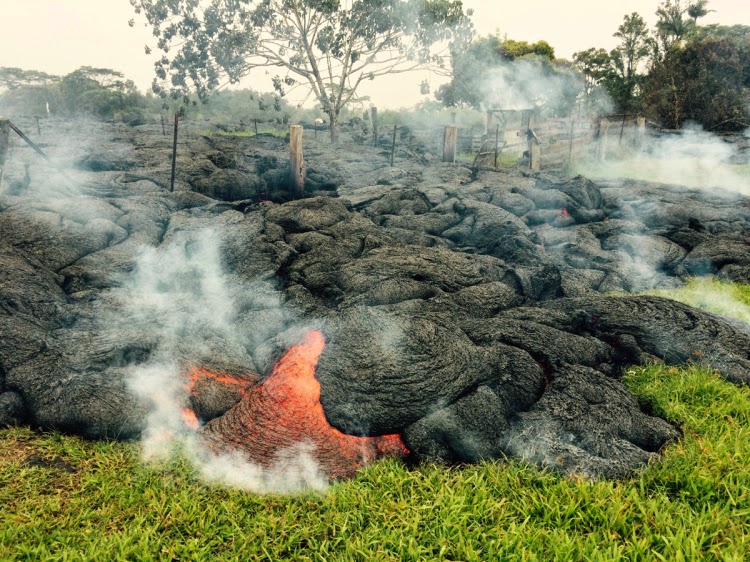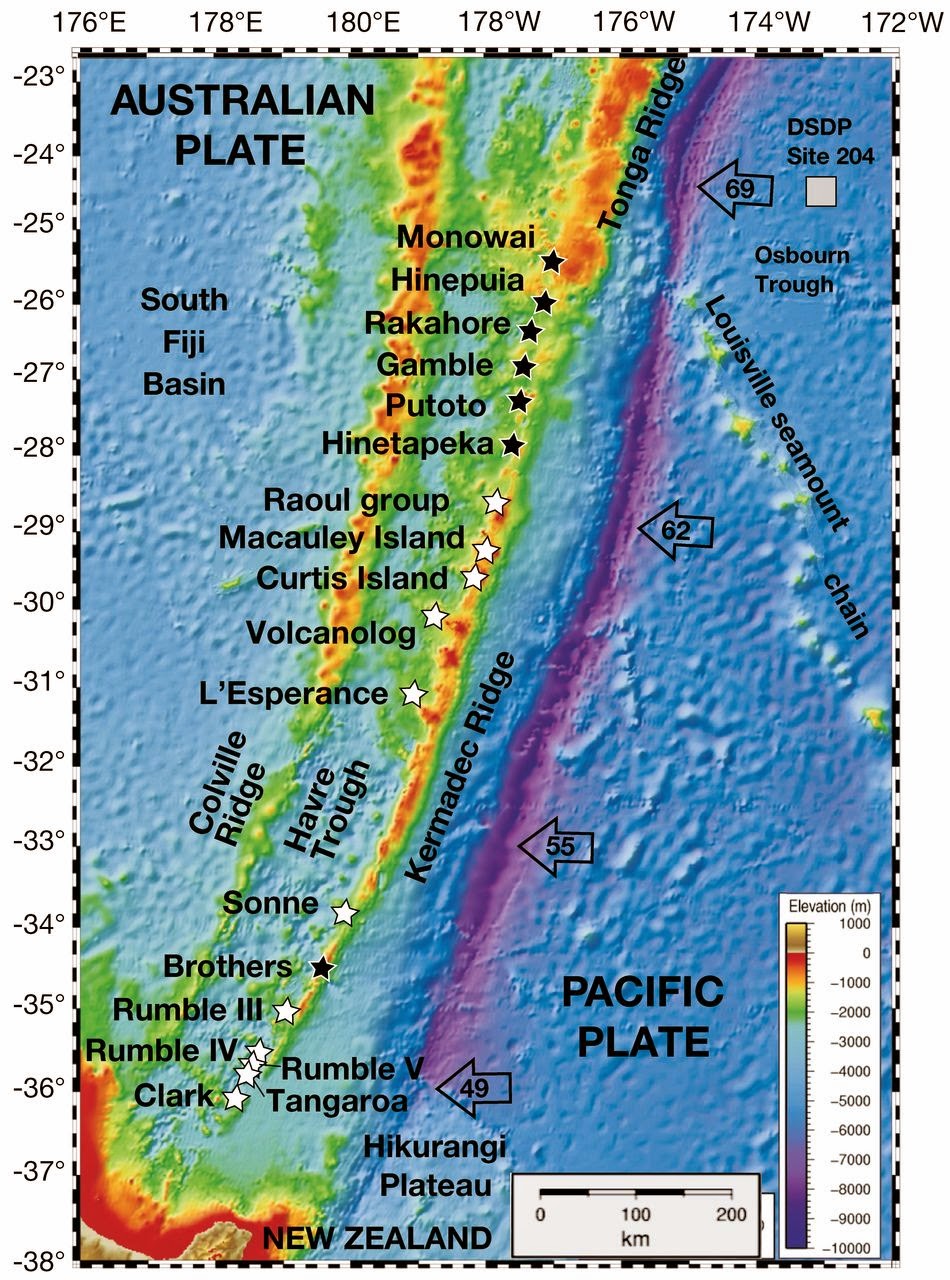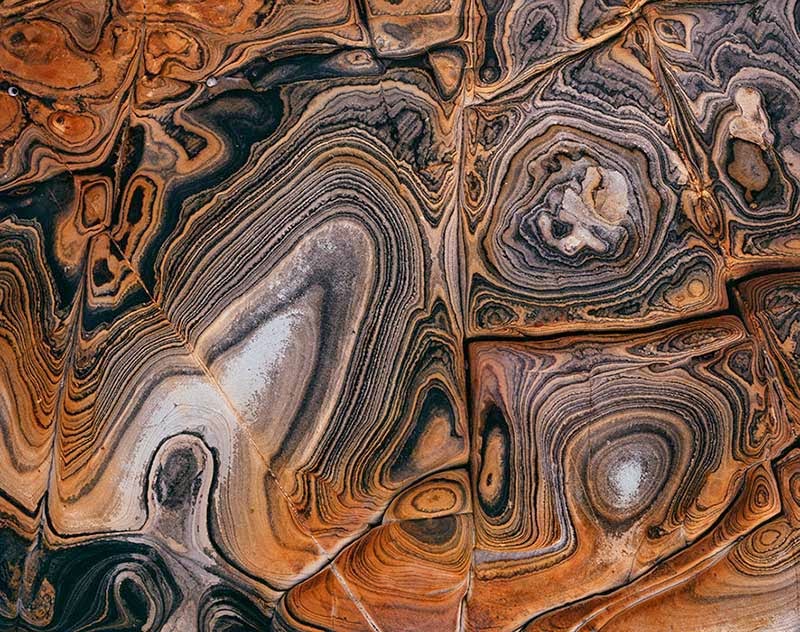LAVA FLOW IN PAHOA PADDOCK
LAVA CROSSING PAHOA ROAD
AERIAL VIEW LAVA APPROACHES PAHOA
OLD TIRES ON FIRE
NIGHT-TIME VIEW FROM OUTSKIRTS OF PAHOA
EERIE NIGHTSCAPE
PU'U O'O: SOURCE OF THIS FLOW
CURRENT FLOW FOLLOWS RIFT ZONE
PU'U O'O
KILAUEA FLOWS
PU'U O'O
KILAUEA CRATER AT NIGHT IN FEBRUARY
KILAUEA JUST AFTER SUN-RISE
VISUAL and INFRARED VIEW, CURRENT FRONT
PU'U O'O
MY FIRST LAVA PHOTO AT KALAPANA
KALAPANA
KALAPANA REVEGETATING
VOLCANIC BEACH TYPICAL OF BIG ISLAND
PU'U O'O ERUPTING
LO'IHI UNDERSEA VOLCANO
PU'U O'O
RUMBLE SEAMOUNTS OFF NEW ZEALAND
KERMADEC TRENCH
TECTONIC PLATES
SOUTHERN CROSS IN PLUME OF KILAUEA
NOTE FROM JEFF: This time last year I was living in and around the little town of Pahoa, in the Puna region of the Big Island of Hawai'i. My experiences with the volcanos was by far the most intense aspect of my time there. I've been really drawn to volcanos since around 2005, when I visited White Island, an active volcano about 50kms off the coast of the north island of New Zealand. Hawai'i Volcanos National Park totally blew me away; the sheer enormity and 'alien-ness' of the landscapes were mind-blowing, plus the awesome raw power of Pele, Gaia's fiery Hawai'ian daughter.
This posting is not an an exercise in vulcanology; to me, the 'coolest' thing about volcanos is not only how HOT they are, but that in a very real sense, they are the way that Mother Earth actually 'gives birth' to new land.
"One of the most active volcanoes on earth,
4,091-foot Kilauea has been erupting almost continuously since 1983. Its
outflow produces enough lava to resurface a 20-mile-long, two-lane road every
day; as a result, the island’s size has grown by 491 acres over the past two
decades. This place is the legendary home of Pele, the fire goddess."
One of the most amazing experiences I had on the Big Island was when my friend and I camped out in a grove of huge eucalyptus trees only a kilometre from the overlook down into the Kilauea crater. As this was in February, we were able to see the Southern Cross in the wee hours of the morning rising over the caldera. Incredibly awe-inspiring.
In June a new lava-flow or 'break out' occurred from the Pu'u O'o vent which is to the east of Kilauea. This flow went beneath the surface for a while and resurfaced a couple weeks ago. In that time it has been steadily advancing directly towards the town of Pahoa. As you would expect, the lava basically follows the path of steepest descent. It's not moving very fast, but recently has been traveling at 15-20 metres per hour.
As I write this now, national news services have picked up this story as of about two days ago. With the lava moves within a few tens of metres of homes, evacuation plans are ready to be enacted.
A field of advancing lava would be a very freaky thing to witness. The night sky is aglow with eery colours, and the sounds I hear are quite spooky, too. Anything the lava comes into contact with is instantly burned up or ignited. So far this has been vegetation, grass in paddocks, forests. But today, as it is approaching civilization, man-made things are burning, like a huge pile of old tires. The smoke and fumes from all this can be quite toxic, as the volcanic emissions alone contain extremely high levels of sulfur compounds.
Power-lines and poles with electrical cables can easily come down in the lava, taking out power and communications. Imagine what could happen when the lava surrounds, for example, an LPG cylinder at someone's house, or if it reaches the service station where underground tanks store tens of thousands of litres of fuel.
I would like to extend my greatest empathy and sympathy for the people and landscapes of the Pahoa area. In times like this, what people are really made of comes to light, and a true sense of community springs to life.
In some ways this can be seen as a 'natural disaster' but I think that a more powerful way to look at it is as a very special and sacred moment in time, where Mother Pele is literally reaching out as she is giving birth...a time of celebration, a rare and wonderful opportunity to witness and be part of such an amazing process. I can't think of anywhere else on Earth one could experience this. If I were there now, not only would I be trying to help anyone in any way that I could, in between that I'd be right at the lava flow front with my flute and drum, playing music in honour of Pele and her newest-born 'fingers' of the body of Mother Earth.
I am in awe of what is going on there right now, a true spectacle of the beauty and power of nature, totally beyond the control of humanity.
And things could be a lot worse: imagine just how much molten lava the Earth contains? Probably on the order of millions of cubic miles. And it could be coming out a lot faster or even exploding!!! :)
'MAGMA OCEANS BENEATH EARTH'S CRUST'
http://www.livescience.com/29702-magma-oceans-possibly-beneath-earth-crust.html
And things could be a lot worse: imagine just how much molten lava the Earth contains? Probably on the order of millions of cubic miles. And it could be coming out a lot faster or even exploding!!! :)
'MAGMA OCEANS BENEATH EARTH'S CRUST'
http://www.livescience.com/29702-magma-oceans-possibly-beneath-earth-crust.html
CURRENT BIG ISLAND SCENARIO
Here are a few breaking articles:
http://www.nbcnews.com/news/us-news/lava-flow-hawaii-gains-speed-triggers-methane-explosions-n234516
'HAZARDS ASSOCIATED WITH LAVA FLOWS'
https://www.youtube.com/watch?v=qXStOFKJ-tQ
'HAZARDS ASSOCIATED WITH LAVA FLOWS'
https://www.youtube.com/watch?v=qXStOFKJ-tQ
'HAWAI'I ISLANDS: VOLCANOS & EARTHQUAKES'
https://www.youtube.com/watch?v=78YLq-5MaOo&sns=fb
'PELE'S GARDEN'
Film by Alexander Hanzlik, awesome didge playing
https://www.youtube.com/watch?v=oM3fmuFP7Z4&feature=youtu.be
'PELE'S GARDEN'
Film by Alexander Hanzlik, awesome didge playing
https://www.youtube.com/watch?v=oM3fmuFP7Z4&feature=youtu.be
HAWAI'IAN VOLCANOS OBSERVATORY
The primary source of a full spectrum of information on Big Island volcanos.
INFORMATION ON TWO NEW SUBMARINE VOLCANOS, LOI'HI OFF THE SOUTH COAST OF THE BIG ISLAND & RUMBLE 3, LESS THAN 100 KMS FROM WHERE I AM HERE ON GREAT BARRIER ISLAND NEW ZEALAND
GLOBAL VOLCANO MONITORING SITE










































































